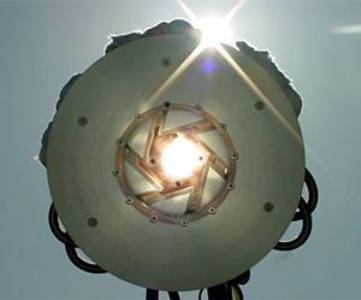SHEC Labs develops super efficient Solar Thermal technology

When in school most of us have tried lighting a match stick with a magnifying glass, focusing all its power on one point to get fire. Well, what if you take that principle and develop a device that can provide energy for a generator to work? Canadian energy company Solar Hydrogen Energy Corporation (SHEC) Labs has developed the world’s most efficient solar thermal technology. They have developed a concentrator and complementary receiver technology that is able to concentrate sunlight up to 5,000 times the intensity that normally would fall on a surface on earth. This immense solar concentration can create heat at the focal point that approaches the surface temperature of the sun at 6,000 °C (11,000 °F). Metal placed at the focus is instantly melted. In commercial scale systems, SHEC expects that the concentrations could be as high as 11,000 to 16,000 times the intensity of the sun. Applications of this technology are power generation; process heating, district heating, water distillation, synthesis gas (syn gas) production which can be used for the production of alternative fuels including hydrogen and other applications. Using thermal heat to convert methane, such as is collected off landfills, into hydrogen and syngas. The combined H and syngas, also called “hythane” can be used in vehicles that run on natural gas. A landfill in Texas, in process of implementing this technology by SHEC, will be able to fuel 5,000 fleet vehicles per year. Another plant further along in Regina, SK, Canada, will produce enough gas to fuel 800 vehicles per year. SHEC says their technology has been very challenging to develop, taking the span of a decade to work out the details of the process and materials. The materials and method for making this receiver tube are proprietary, but the materials consist of natural, not exotic, elements.
 In the commercial unit, the receiver apparatus will be about the size of a 45-gallon drum, and the aperture and tube will be around four inches in diameter. Would be a really cool sight if household versions of this technology come out, best of all will be no more power bills.
In the commercial unit, the receiver apparatus will be about the size of a 45-gallon drum, and the aperture and tube will be around four inches in diameter. Would be a really cool sight if household versions of this technology come out, best of all will be no more power bills.
Via